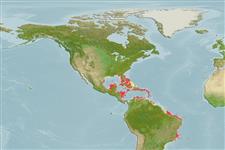>
Syngnathiformes (Pipefishes and seahorses) >
Syngnathidae (Pipefishes and seahorses) > Syngnathinae
Etymology: Micrognathus: Greek, mikros = small + greek, gnathos = jaw (Ref. 45335).
More on author: Jenyns.
Environment: milieu / climate zone / depth range / distribution range
Ecología
marino asociado a arrecife; rango de profundidad 1 - 21 m (Ref. 52313). Subtropical; 32°N - 33°S
Western Atlantic: Bermuda and the Bahamas to Santa Catarina, Brazil (Ref. 57756); including lower east Florida coast but absent from the Gulf of Mexico except for a single record from Cayo Arcas, Mexico. Dawson (1982) noted that there are two distinct color patterns of this species with no definite intergrades. Some authors are of the opinion that these color extremes represent two different species and should this be true, Dawson stated that Kaup's vittatus has priority over ensenadae with AMNH 7792 documenting the Bermuda occurrence of Micrognathus vittatus.
Tamaño / Peso / Age
Maturity: Lm ? range ? - ? cm
Max length : 15.0 cm TL macho / no sexado; (Ref. 7251)
Short description
Morfología | Morfometría
Radios blandos dorsales (total): 19-21; Radios blandos anales: 1 - 3. Possess nine (9) different color phases. Similar to Halicampus zavorensis, it has a short snout (2.7-3.7 in HL) with a continuous and essentially linear median dorsal ridges. Different with H. zavorensis in having 17-18 trunk ridges (vs. 14); 32 - 35 tail rings (vs. 36 - 37); and having 18 - 22 dorsal-fin rays (vs. 22 - 23) (Ref. 52313).
Occurs in pockets of coral rubble (low coral growth on white sand bottom), usually in the vicinity of sea fans (Ref. 5521, 7251, 9710). Ovoviviparous (Ref. 205). The male carries the eggs in a brood pouch which is found under the tail (Ref. 205).
Life cycle and mating behavior
Madurez | Reproducción | Puesta | Huevos | Fecundidad | Larva
Male carries the eggs in a brood pouch (Ref. 205).
Robins, C.R. and G.C. Ray, 1986. A field guide to Atlantic coast fishes of North America. Houghton Mifflin Company, Boston, U.S.A. 354 p. (Ref. 7251)
IUCN Red List Status (Ref. 130435)
Threat to humans
Harmless
Human uses
Más información
Age/SizeCrecimientoLength-weightLength-lengthLength-frequenciesMorfometríaMorfologíaLarvaDinámica larvariaReclutamientoAbundanciaBRUVS
ReferenciasAcuiculturaPerfil de acuiculturaRazasGenéticaElectrophoresesheritabilidadEnfermedadesProcesamientoNutrientsMass conversion
ColaboradoresImágenesStamps, Coins Misc.SonidosCiguateraVelocidadTipo de nataciónSuperficie branquialOtolitosCerebrosVisión
Herramientas
Special reports
Download XML
Fuentes de Internet
Estimates based on models
Preferred temperature (Ref.
123201): 25.8 - 28.2, mean 27.4 °C (based on 694 cells).
Phylogenetic diversity index (Ref.
82804): PD
50 = 0.5039 [Uniqueness, from 0.5 = low to 2.0 = high].
Bayesian length-weight: a=0.00037 (0.00016 - 0.00085), b=3.18 (2.99 - 3.37), in cm total length, based on LWR estimates for this (Sub)family-body shape (Ref.
93245).
Nivel trófico (Ref.
69278): 3.3 ±0.4 se; based on size and trophs of closest relatives
Resiliencia (Ref.
120179): Alto, población duplicada en un tiempo mínimo inferior a 15 meses (Preliminary K or Fecundity.).
Fishing Vulnerability (Ref.
59153): Low vulnerability (10 of 100).
Nutrients (Ref.
124155): Calcium = 80 [38, 191] mg/100g; Iron = 0.927 [0.464, 1.736] mg/100g; Protein = 18.7 [17.4, 19.9] %; Omega3 = 0.171 [0.088, 0.330] g/100g; Selenium = 15.3 [6.4, 38.2] μg/100g; VitaminA = 45 [13, 164] μg/100g; Zinc = 1.21 [0.73, 1.96] mg/100g (wet weight);
